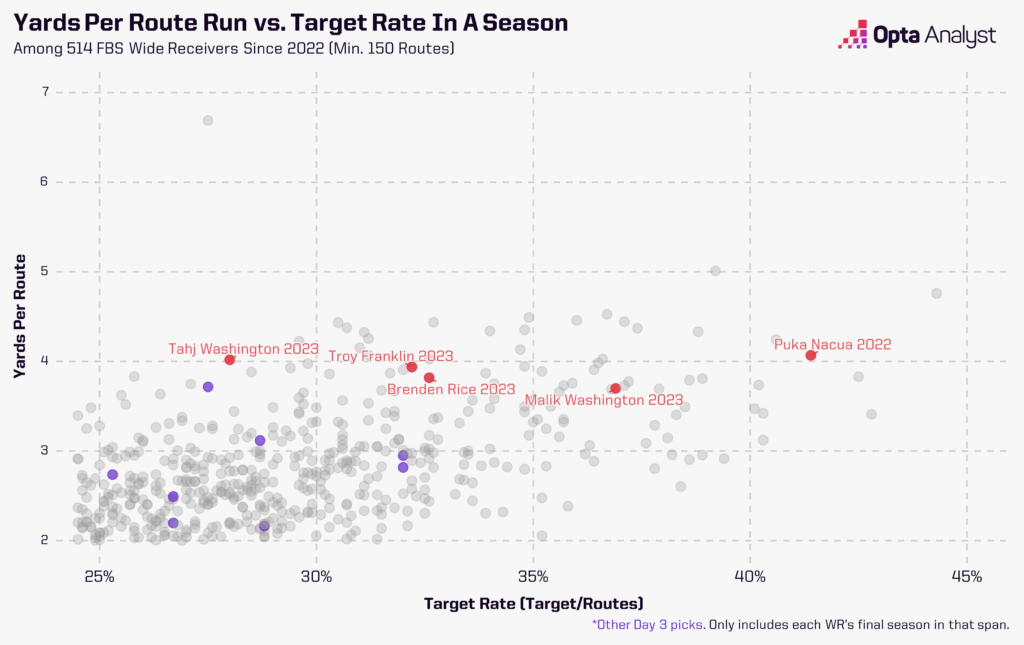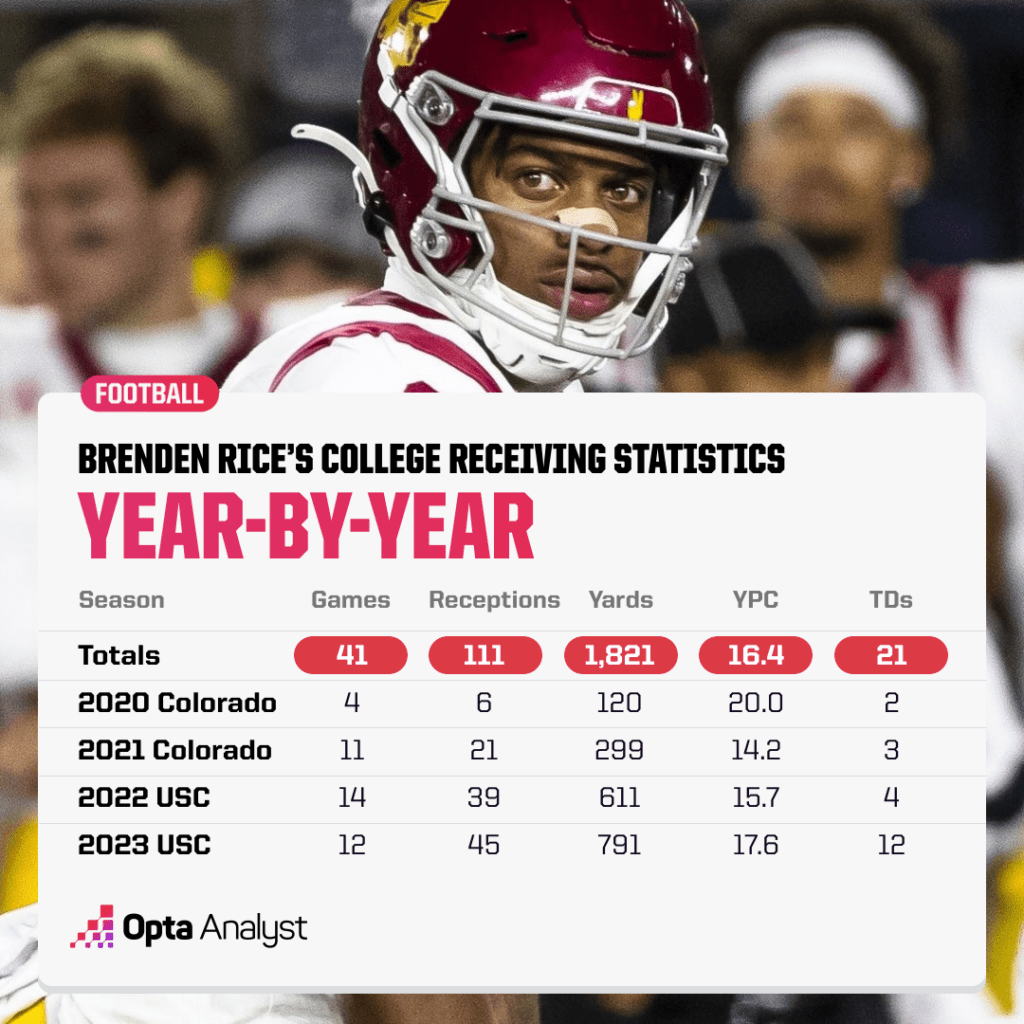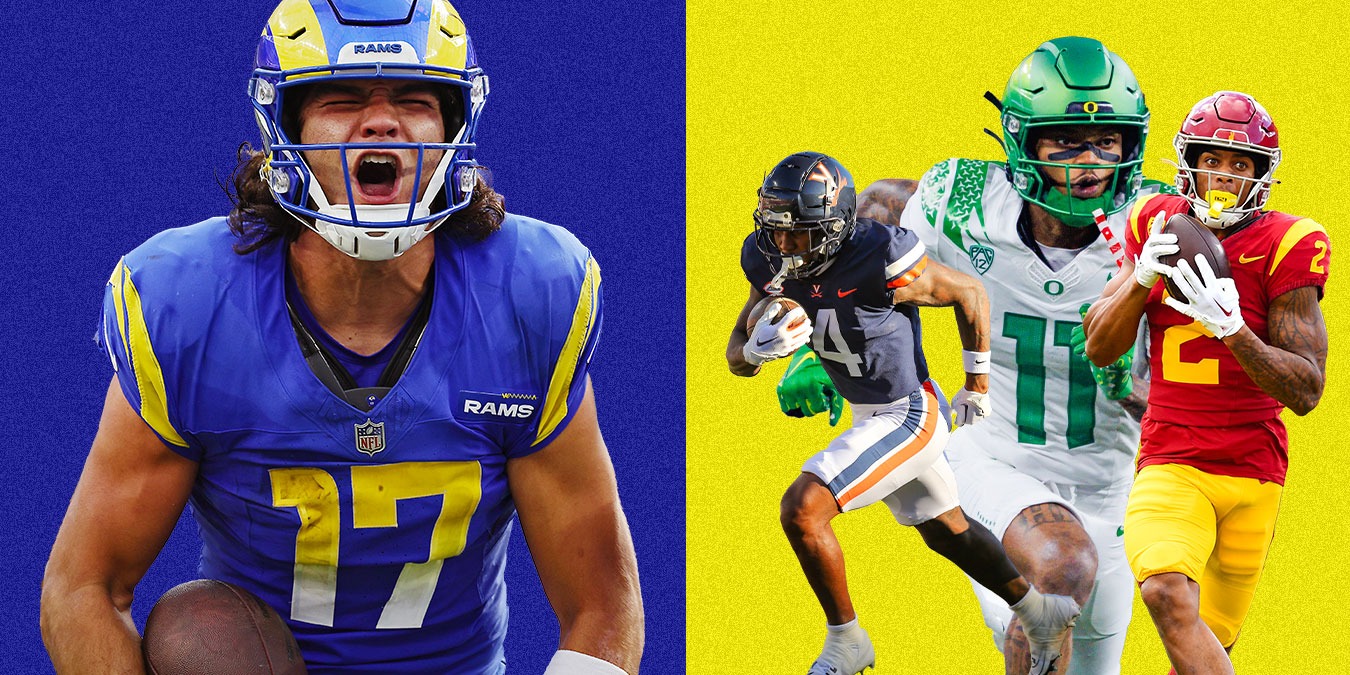Among the best stories of the 2023 NFL season was the breakout of Los Angeles Rams wide receiver Puka Nacua.
In April 2023, Nacua was the 20th selection in the NFL Draft… at his position.
Just over a year later, the BYU product – who was selected 177th overall among all players, for what it’s worth – has set all-time rookie records for receptions (105) and receiving yards (1,486), along with being an AP NFL All-Pro Second Team selection.
Nacua’s remarkable story, which saw him go from a collegiate career high of 805 receiving yards to nearly doubling that total in his first professional season, has everyone asking one question: Who could be next?
Of course, to imply there certainly will be a “next Puka Nacua” would be hasty. Rookie receivers simply don’t go for 1,400 or more yards very often, and when they do, they’re typically first-round picks like Ja’Marr Chase (Cincinnati Bengals) and Justin Jefferson (Minnesota Vikings), not players who were the final pick of the fifth round.
Nonetheless, it’s the offseason, which means it’s the proper time to speculate about hypotheticals like this.
Here are the parameters for what it would mean to be the “next Puka Nacua,” and who has the best chance of fitting the bill from this year’s rookie wide receiver class:
Rule 1: Day 3 NFL Draft Pick
This is the most straightforward qualification of all. If someone like Marvin Harrison Jr., Malik Nabers or Rome Odunze breaks every rookie receiving record in sight, he doesn’t get the acclaim of being the “next Puka Nacua.” A core premise of the Nacua story is his success relative to his NFL Draft status.
So where do we draw the line? We could set a hard mark at his overall draft slot (177th) or his slot within his position group (20th), but this feels like it would be too harsh. If a player who happened to be picked in the middle of the fifth round rather than the very end of it went on to be a Pro Bowler as a rookie, we’d all still be (correctly) hailing it as an extremely impressive story.
As such, a proper middle ground is to consider all players picked on the third and final day of the draft, which entails the fourth through seventh rounds. Of the 35 wide receiver selections this year, 19 were chosen on Day 3, giving us a wide range of names to pick from.
Rule 2: Non-Elite College Counting Stats
While this is conceptually similar to Rule 1, there is a distinction worth mentioning. Nacua wasn’t a collegiate All-American who unexpectedly slipped in the NFL Draft due to size or character concerns. In contrast, by the sheer “meat and potatoes” statistics that fans are used to seeing on TV, he simply wasn’t among the nation’s best.
Nacua was not heavily targeted during two seasons (2019 and ’20) at Washington (only 16 receptions) prior to making a transfer to BYU. His career-high 805 receiving yards occurred in his first season with the Cougars in 2021, and he had 625 receiving yards and five touchdown catches in nine games in his final season a year later. BYU used him as a rusher more than the typical wide receiver, but he didn’t reach 1,000 scrimmage yards in any of his college seasons.
How does this become relevant here? Consider Oregon’s Troy Franklin, for example. Although he slipped into the fourth round of the 2024 NFL Draft, he was one of four FBS players to have at least 1,200 receiving yards and 12 receiving touchdowns last year, along with the aforementioned three top-10 picks (Harrison, Arizona Cardinals; Nabers, New York Giants; and Odunze, Chicago Bears).
For Franklin to put up those kinds of numbers, while playing for a team that was in College Football Playoff contention most of the season, and while earning All-America Second Team honors in the process, means it probably wouldn’t surprise many fans to see him have immediate pro success.
As such, when we seek the “next Puka Nacua,” the search will be limited to players who weren’t necessarily among the bigger names at their position when they were at the college level.
Rule 3: High Target Rate
Now we get into the rules that maybe aren’t so obvious. A fundamental truth of football, at any age level, is a receiver probably is doing something right if the quarterback is looking his way regularly.
But we can verify Nacua fit this bill in his time with BYU – and that’d be an understatement. In 2022, he was targeted on a staggering 41.4% of his routes. That ranked second in the FBS among players with at least 150 routes behind Xavier Weaver of USF. Since 2016, it’s the fourth-highest rate by any player in his final collegiate season.
Nacua simply didn’t run that many routes, both because he was limited to nine games and because BYU was a run-heavy team, but when he did, Jaren Hall didn’t hesitate to treat him as the first option.
As a matter of fact, Nacua’s “usage rate” (a relatively simple metric that accounts for a player’s targets and carries divided by his total offensive snaps) was 27.2% in 2022. That’s the highest by any FBS wide receiver with at least 150 routes in his final collegiate season since 2016. And the trait certainly carried over to the professional level last year: Nacua ranked ninth as an NFL rookie in target rate (minimum 250 routes), along with finishing in a tie for sixth in total targets.
Which players in this year’s NFL Draft class fit the mold? Virginia’s Malik Washington stands out, as his 36.8% target rate last year led all wide receivers who were drafted last month, let alone just the Day 3 picks. Beyond him, Florida State’s Johnny Wilson, Franklin, Louisville’s Jamari Thrash, and USC’s Brenden Rice all stood out among the Day 3 group with target rates of at least 30%.
Rule 4: Strong Production on a per-Route Basis
Being targeted often isn’t quite the whole story, however. What’s also indicative of future pro success is a player’s ability to produce on his targets. Specifically, much public research has been done to hail the prowess of receiving yards per route run as a predictive tool, and our data is capable of diagnosing this at the college level.
As you might expect, this was another area Nacua excelled in during his final year at BYU despite his ostensibly pedestrian raw counting stats.
He averaged an impressive 4.07 yards per route run (YPRR) in 2022, ranking second to UAB’s Trea Shropshire among FBS wide receivers who were in their final collegiate season. Nacua also averaged 0.302 receptions per route that season, ranking fifth among receivers in their final season since 2016 behind some impressive names.
Given Nacua’s 105 receptions last year, clearly this trait transferred over.
Most Catches/Route in Final College Season – Since 2016 (min. 150 routes)
- Parris Campbell, Ohio State, 2018: 0.316
- DeVonta Smith, Alabama, 2020: 0.310
- Elijah Moore, Ole Miss, 2020: 0.309
- Drake London, USC, 2021: 0.307
- Puka Nacua, BYU, 2022: 0.302
How about the rising rookie crop? USC’s Tahj Washington was the only Day 3 pick to surpass four receiving yards per route last season (4.02), ranking second among all drafted receivers behind Nabers (4.46). Franklin, Rice, UCF’s Javon Baker and Malik Washington earned at least 3.5 YPRR.
With this in mind, we can refine our “next Puka Nacua” candidates a bit further. Among the 19 receivers picked on Day 3, four of them had at least a target rate of 28% and at least 3.5 YPRR at the FBS level last season – Franklin, Rice, Tahj Washington and Malik Washington.
If we raise the minimum target rate from 28% to 30%, then Tahj Washington falls off from that list.
But there’s one important characteristic left for any aspiring Nacua successor.
Rule 5: Immediate Window to Play
A talented player won’t be setting records without playing time. Nacua was a perfect example of this a year ago.
As successful as Nacua was in his rookie season, he was a beneficiary of Cooper Kupp’s early season hamstring injury, not to mention the Rams weren’t particularly deep at wide receiver even when Kupp was healthy (they were the only wide receivers on the team to finish with at least 500 receiving yards – Tutu Atwell came in third with 483).
Unfortunately, this isn’t the best sign for either of the Washingtons, who coincidentally were both picked by the Miami Dolphins (Malik in the sixth round and Tahj the seventh). Even if we disregard them competing against one another, the AFC East squad returns the first-team all-everything duo of Tyreek Hill and Jaylen Waddle, along with Braxton Berrios and new free agent signee Odell Beckham Jr. There will only be so many targets to go around for coach Mike McDaniel’s offense, and the Washingtons might struggle to get their share as rookies.
In contrast, take a look at Rice’s roster with the Los Angeles Chargers. That team lost both Keenan Allen and Mike Williams due to cap concerns this offseason, leading the NFL world to collectively ask what the team’s plan was at the position entering the 2024 NFL Draft.
The Chargers do not have a wide receiver on their roster who had at least 600 receiving yards at the NFL level last season (Josh Palmer’s 581 lead the way), and the team has an extremely talented young QB in Justin Herbert who needs to get the ball somewhere.
When you combine those factors with the aforementioned college stats, our final answer is …
The ‘Next Puka Nacua’
USC’s Brenden Rice, the son of Jerry Rice – surely the greatest wide receiver of all time – is the most likely “Puka Nacua” of 2024.
Franklin, Tahj Washington, Malik Washington and Rice all provided compelling arguments, and all certainly have potential to make an immediate impact on Sundays.

Franklin, in particular, was an alluring choice, as he joins the Denver Broncos’ relatively unproven receivers unit (although they still have Courtland Sutton). But as was discussed earlier, Franklin was more or less disqualified due to being too good, as it’s difficult to consider a reigning second-team All-American who starred for the nation’s No. 2 scoring offense to be much of a dark horse.
As for the Washingtons, both receivers showcased some elite traits in college, but the presence of Hill and Waddle will be tough to overcome as it pertains to significant rookie production.
Rice, meanwhile, shares tons of similarities to Nacua beyond their Day 3 sleeper status or the advanced metrics. They’ll share the same age (22) as rookies, having transferred after their first two years – Nacua going from Washington to BYU and Rice from Colorado to USC.
Both had relatively limited college production in terms of counting stats, with Rice’s career high of 791 receiving yards close to Nacua’s 805.

Both have wildly similar physical profiles with Nacua listed at 6-foot-2, 205 pounds and Rice at 6-2, 208. And, of course, both were drafted by Los Angeles teams, with Nacua going to the Rams and Rice to the Chargers.
Does any of this guarantee that Rice will be the next Nacua? Of course not. Given that he was a seventh-round draft pick for a team that picked two other wide receivers in the same class (including Georgia’s Ladd McConkey in the second round), there’s still work to do to even make the roster, let alone earn a starting job.
But the leadup to training camp is a good time for speculation, and based on everything from advanced analytics to the home stadium shared by their NFL teams, these two have a lot more in common than meets the eye.
Enjoy this? Check out our MLB, NBA and NFL coverage, and follow along on X and Instagram for more.
